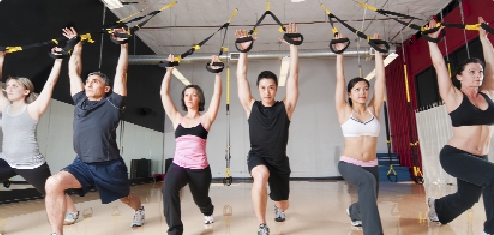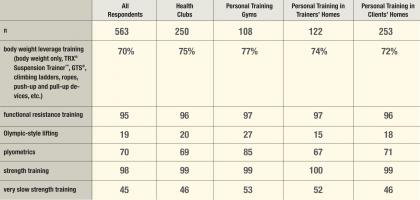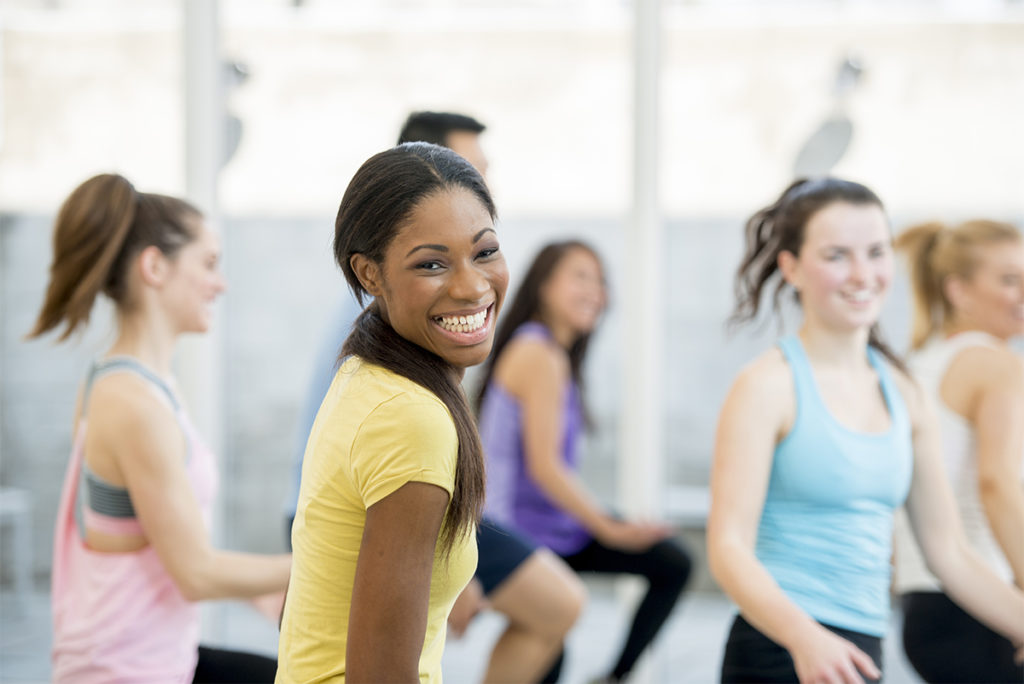2010 IDEA Personal Training Programs & Equipment Trends
With average retention rates of 75%, IDEA personal trainers are leveraging the best of their programs and equipment to keep clients coming back for more.
Download Additional Survey Information

When you have been in the same business for many years, it can be challenging to stay fresh and keep your services exciting and appealing to your customers. Fortunately, personal training is somewhat of an anomaly in that regard. In fact, every year for the past several years of this survey, there have been so many changes in training philosophies and client profiles, so many product advancements and so much creativity in programming that the industry has practically managed the “staleness” factor for professionals.
This does not mean, however, that personal trainers should feel they can slack off or assume they will maintain their numbers without continually boosting their programs and equipment knowledge and maintaining currency in continuing education. Precisely the opposite is true. Competition in this field is greater than ever. Well-informed, well-educated personal trainers will always rise to the top because of their creativity and because they know their options. This trends report can help you make sound decisions about what clients are clamoring for (based on your colleagues’ experience) in the realms of programming and equipment.
Respondents to this survey come from all areas of the country; work in various types of facilities; train a widely varied clientele; and incorporate diverse types of equipment and programming to meet the needs of their clients.
Trainers report that they retain 75% of their clients for 1 year or longer. An even closer look reveals that about one-third of clients stay with their trainer for more than 5 years (31%), while the remaining clients stay 1–2 years (21%), 2–3 years (20%), 3–4 years (11%), less than 1 year (10%) and 4–5 years (8%). Since it’s easier to maintain an existing customer than it is to recruit a new one, what lessons can be learned from IDEA trainers on the retention front? What are they doing with programs and equipment that sets them apart?
The Global View
Broadly speaking, IDEA personal trainer members who completed the 2010 IDEA Personal Training Programs & Equipment Trends survey see two developments topping this year’s list: (1) the incorporation of small, portable equipment into small-group sessions that focus on strength and functional training and (2) a focus on older adults and those interested in weight management. Training adults one-on-one remains the main business concentration. Training sessions center on strength training, stretching, balance and functional resistance training.
These are the session options offered by at least 50% of survey respondents:
99% personal training, adult, one-on-one
98 strength training
97 stretching and/or flexibility
95 balance training
95 functional resistance training
87 flexibility, range-of-motion assessment
85 height, weight assessment
84 personal training, 2 clients share
83 training for weight management
82 balance assessment
81 cardiorespiratory interval training
81 body composition assessment
79 circumference measurements
79 posture assessment
77 muscular strength assessment
77 resting heart rate assessment
77 cardiorespiratory circuit training
77 cardiorespiratory endurance training
73 cardiorespiratory cross-training
72 senior-specific training
72 back pain prevention
70 body weight leverage training
(body weight only, TRX® Suspension Trainer™,
GTS® [Gravity Training System], climbing ladders, ropes,
push-up and pull-up devices, etc.)
70 plyometrics
69 muscular endurance assessment
67 activity heart rate assessment
67 postrehab following injury
65 personal training, youth, aged 18 or younger, one-on-one
65 speed, agility, quickness conditioning
64 cardiorespiratory endurance assessment
64 blood pressure assessment
61 nutrition coaching
59 exercise for chronic medical conditions
(e.g., diabetes, coronary heart disease)
58 nutrition assessment
57 personal training, 3–5 clients share
57 sport-specific training
56 personal training, outdoor sessions
50 small-group circuit training
Are Program Trends Supported by Services Offered?
When asked about program trends for 2010, survey respondents wrote in “senior fitness,” “weight management” and “small-group and partner training” as the top three program trends within personal training. Among the options respondents currently provide, these programs are clearly popular, with 72% offering sessions specific to senior fitness, 83% offering weight management sessions, and 84% and 57% offering partner and small-group training, respectively.
With regard to senior fitness, Tammy Petersen, founder and managing partner of American Academy of Health and Fitness in Kansas City, Kansas, shares some facts and figures that have influenced her company’s decision to serve the senior population: “On January 1, 2006, the first of the Baby Boomers, born between 1946 and 1963, started turning 60. This group is touted as the generation that created the modern health club industry. It is the largest (78 million), most health-conscious and most appearance-conscious generation in U.S. history. This group has more than 50% of the [nation’s] discretionary income; and [Boomers] spend more of their income on health than any other item, according to the World Health Organization. In addition, according to IDEA Health & Fitness Association’s research, 51% of all personal training [clients] are over the age of 45. There is a huge opportunity for trainers to make an impact in the lives of this population.”
Trends in Weight Management Programming
Weight management was identified as one of the top three program trends for the year. More than 80% of survey respondents report that they offer weight management–focused training sessions. If we look at types of training methods used to manage weight, we find that more than 70% of respondents offer various methods of cardiorespiratory training (intervals, circuit, endurance, cross-training); however, respondents devote only 22% of a session to cardiorespiratory training. Fewer than 70% offer activity heart rate assessment, cardiorespiratory assessment, heart rate monitor training, nutrition assessment or nutrition coaching, all of which are important aspects of weight management programming.
Is the personal training industry doing all it can to assist clients in overcoming the challenges related to weight management? Nicki Anderson, president of Reality Fitness Inc. in Naperville, Illinois, reminds us that weight loss is not one-dimensional; it’s not just about the weight loss.
“These clients struggle because as trainers we can rarely give them the support (both emotionally and mentally) that they need in order to be successful for the long term,” Anderson observes. “There are other elements involved. Hence you need to create a ‘triage,’ if you will, with other health professionals. It is important to have a professional network so you can connect with those who can best help your client. For example, I take care of the exercise component; I have a wonderful therapist who may help with the mental aspects of weight loss and a registered dietitian who shares my philosophy about healthy eating.”
Shannon Fable, owner of Sunshine Fitness Resources LLC in Boulder, Colorado, agrees. “Weight management is definitely moving to the forefront,” she says. “Trainers should work with nutritionists to provide the full package for clients. While exercise is important, we are finding that without help in the food department, folks aren’t meeting their goals in the desired time frame.”
Personal Training Formats Continue to Expand
In length, training sessions remain much the same as they have been traditionally. The majority (91%) of respondents report offering 60-minute training sessions, while 30% offer 30-minute sessions (30%) and 12% offer 45-minute sessions. The largest increases in personal training options offered from 2007 to 2010 were for small-group sessions shared by 3–5 clients (44% to 57%) and partner sessions (77% to 84%).
Ali Ingalls, certified personal trainer at Sport & Health Club in Gaithersburg, Maryland, believes these options are gaining ground for several reasons. “This type of training is cost-effective for the clients. One-on-one training can be costly to the average individual, especially in this economy. Small-group training costs less for the participants, as they share the cost of the training,” she says. “I also believe small-group training is more motivating. Many people don’t like exercising by themselves. These clients would rather exercise in a group setting with a trainer leading them to their goals. The others in the group help form a support system [and add] a little friendly competition. Group and partner training make the experience more enjoyable and more interactive.”
When comparing types of sessions offered at different facilities, it is interesting to note that youth personal training (one-on-one and small-group) is more often offered in personal training gyms (84% and 56%, respectively) than in health clubs (69% and 45%, respectively).
Ryan Bishel, director of athlete recruiting at Champion’s QUEST in Los Alamitos, California, identifies with this situation. “Personal training gyms tend to be smaller companies, and smaller companies tend to be more innovative [in generating] ideas to increase revenue. Larger health clubs are more inclined to keep their focus on the general membership, group exercise and personal training,” Bishel says. “Youth fitness is also a tough market to sell. Parents are the ones paying for it, and most parents in a health club either think, ‘They are too young for me to pay for a personal trainer’ or ‘They can just work out with me, and I can show them what to do for an extra $19 per month.’ Parents are very protective of who works with their kids. They require a more ‘personal relationship’ with whomever is interacting with their kids, and trainers at smaller gyms tend to have that more emotional connection with the clientele.”
What Methods Are Used for Resistance Training?
When evaluating the composition of a typical session, IDEA trainers say they devote 53% of the time to resistance training. During resistance training sessions, almost all trainers use strength training and functional resistance training (98% and 95%, respectively), and the majority use body weight leverage training and plyometrics (70% for each method). About half of surveyed trainers use very slow strength training (45%), while just a few use Olympic-style lifting (19%).
Eric Beard, MS, fitness director and master trainer at Longfellow Sports Club in Natick, Massachusetts, is not surprised by these trends: “Strength training in its various forms is definitely king in the fitness industry. The resurgence of body weight training has been fun to see, with our industry’s early roots in the original Muscle Beach (think gymnasts, not bodybuilders),” he observes. “Boot camps, studios and the growth of the independent trainer could explain the growing trend of body weight and functional styles of training, [since] space and equipment are at a premium. I also believe that the average client has poor posture and cannot get the most out of linear-path, fixed-form selectorized machines. Trainers are seeing that Olympic-style lifting is truly an art that must be refined over years of rehearsal and is not conducive to the abilities, dedication levels and goals of most fitness-oriented clients. Super-slow training takes mental discipline and is, well, slow. Most people do not want to focus on one thing for that long; for better or worse, we are in a ‘microwave’ society. Zap it for 30 seconds and then move on!”
Jade Teta, ND, CSCS, holistic physician and owner of Metabolic Effect Inc. in Winston-Salem, North Carolina, adds that innovation in equipment and advanced training methods give professionals the choice to train clients in multiple planes and choose from more functional options. “This translates into trainers who have more knowledge and are better equipped to understand and deliver more sophisticated exercises and programs. A focus on resistance training and functional movement has everything to do, not just with helping clients reach performance and weight loss goals, but also with keeping them healthy and injury free,” Teta says.
Only Two Pieces of Large Equipment Break the Top 10
Survey respondents report using all types of equipment, with an emphasis on smaller, portable pieces. These are the 10 pieces of equipment most frequently available:
98% stability balls
97 resistance tubing or bands
97 barbells and/or dumbbells
93 balance (BOSU® Balance Trainers, disks,
wobble boards, balance boards)
93 medicine balls
88 foam rollers and small balls
84 steps and platforms
77 treadmills
76 weighted bars
70 elliptical trainers
As in the past several years of this report, eight of the top 10 most frequently used pieces of equipment are small and transportable. Daryl Shute, MSc, CSCS*D, education department coordinator at Power Systems Inc. in Knoxville, Tennessee, identifies with the results. “Whether it’s one-on-one, small-group or boot camp–style, the trainer needs portable equipment because large, cumbersome equipment just doesn’t cut the mustard! Stability balls, BOSU balls, medicine balls and balance items have become required equipment for the ‘traveling trainer,’” he says. “With alternative-style training (such as [body leverage] training, sandbags and kettlebells) gaining popularity, the options become limitless. Regardless, a handful of these items is much more economical for the trainer [to have] than treadmills, ellipticals and other typical gym equipment. Bottom line: portability leads to profitability!
IDEA presenter Douglas Brooks, MS, co-owner of Moves International Fitness in Mammoth Lakes, California, concurs. “By using versatile and portable equipment like BOSU Balance Trainers, elastic resistance, TRX and other cutting-edge small equipment, trainers are able to create effective, functional, creative, results-oriented and fun workouts.”
Treadmills and elliptical trainers are the only two pieces of large equipment that made the top-10 list. Interestingly, IDEA trainers also reported these items as two of the top three equipment trends for 2010.
Top Three Equipment Trends
This year’s respondents were asked to write in what they felt were the top three equipment trends of 2010. Elliptical trainers, kettlebells and treadmills came out on top. While kettlebells were a new addition to this year’s survey, treadmills and elliptical trainers have been mainstays for several years. A review of the last 4 years of survey data shows no increase in ellipticals usage and only a small increase in treadmill use (75% to 77%), which seems contradictory to the write-in trend placing them in the top three.
Stephen Holt, chief executive officer of 29 Again Custom Fitness & Wellness in Timonium, Maryland, says he finds it shocking that elliptical trainers and treadmills were ranked so high. “I’m assuming trainers were thinking about what they actually use or see their clients using, versus trends. Sure, elliptical trainers and treadmills are staples, but I don’t think anyone would label them as trends. In fact, I see more trainers moving away from long, slow distance (LSD) cardio and toward metabolic strength training.”
Fable disagrees, saying that in her view, it makes a strong statement to have elliptical trainers and treadmills topping the list. “New products and programs are not necessarily what we need to get new people exercising or even to impress the ones who are already exercising. People like familiarity. We need to focus on how to make these products and programs that people are comfortable with interesting, more accessible and effective!”
About the Survey
The percentage (%) shows the number of survey respondents who answered yes to a given survey question. All percentages have been rounded up at 0.5 and down at 0.4. Percentages do not necessarily total 100, because of multiple or missing responses.
About the Respondents. IDEA personal trainer members who gave us permission to use their e-mail addresses were sent three e-mail invitations to link to a Web-based survey in February 2010. The 563 trainers who responded represent 82% personal trainers, 10% owners, 5% fitness directors, 2% personal training directors and 2% general managers. There was a 7% response rate, with a 95% confidence level and a ±5% margin of error.
About the Demographics. On average, the respondents work at two separate facilities. Fifty-six percent offer personal training in clients’ homes, whereas 27% work in their own homes; 30% offer training in fitness-only health clubs, 25% in multipurpose health clubs, 24% in personal training gyms, 14% in group exercise studios, 13% in parks or recreation programs, 11% in Pilates or yoga studios, 10% in a YMCA/YWCA/JCC, 9% in corporate fitness centers and under 8% in other venues. Most of the respondents are self-employed (65%), while 42% are independent contractors and 33% are employees. Fewer than one-quarter of trainers (23%) sell products to their clientele for an additional revenue source. Location-wise, 37% work in large cities, 36% in small cities or towns, 24% in suburbs and 4% in rural areas. Most respondents live in the United States—32% in the West, 27% in the Northeast, 22% in the North Central region and 19% in the South; 5% live in Canada.
About the Clientele. IDEA trainers serve a predominantly female clientele (72%), with the most common age ranges being 35–44 years (24%), 45–54 years (33%) and 55–64 years (25%). Under the age of 18 (7%), 18–34 (17%) and over 65 years (21%) are less commonly served age ranges. Most clients are at an intermediate (48%) or beginner fitness level (39%), while only 20% are at an advanced level. While 97% of trainers have clients who are apparently healthy, they also train individuals with special medical needs (83%), chronic injury (84%) or physical disabilities (53%). Trainers commonly work with amateur athletes (61%) and less frequently with professional athletes (12%). Most trainers (85%) work with older adults (65 years and older), and almost half of all trainers work with children and teens (aged 18 years or younger) (49%). Just 19% of trainers work with women only.
The average cost of a training session is $56 (median $55). Most clients pay for their training sessions either as a package (76%) or individually (72%). Eighteen percent pay for sessions through a monthly membership fee, and only 5% pay with an annual membership fee.
About Median and Mean. The mean (average) is found by adding together all the numbers and dividing by the number of responses. Very large and very small numbers can create a wide range, which may make an average less representative of most of the people.
The median is the midpoint, meaning 50% of respondents answered above that number and 50% answered below it. A median is useful because it helps eliminate the distortion that an average can cause.
About Health Clubs. The “health clubs” category in the charts includes multipurpose and fitness-only health clubs and YMCA/YWCA/JCC facilities.
Editor’s Note: Look for more facts and figures from this survey in the September issue of IDEA’s e-newsletter IDEA Trainer Success. If you are interested in more information about programs and equipment offered in fitness facilities, look for the report in the July–August issue of IDEA Fitness Manager. For the full copy of either report, call IDEA member services at (800) 999-4332, ext. 7.
Trends in weight management programming.
% of respondents offering the activity.
©2010 by IDEA Health & Fitness Inc. All rights reserved. Reproduction without permission is strictly prohibited.
% of respondents offering the activity.
©2010 by IDEA Health & Fitness Inc. All rights reserved. Reproduction without permission is strictly prohibited.
Personal training formats continue to expand.
What methods are used for resistance training?
% of respondents offering the activity.
©2010 by IDEA Health & Fitness Inc. All rights reserved. Reproduction without permission is strictly prohibited.
Jan Schroeder, PhD
Jan Schroeder, PhD, is a professor and past chair of the department of kinesiology at Long Beach State University. She coordinates and teaches in the fitness and integrated training undergraduate program and has written 60+ articles on exercise physiology/fitness. She is also a certified group exercise instructor who teaches weekly in the private sector. Schroeder is the recipient of the 2021 IDEA Fitness Leader of the Year Award.








